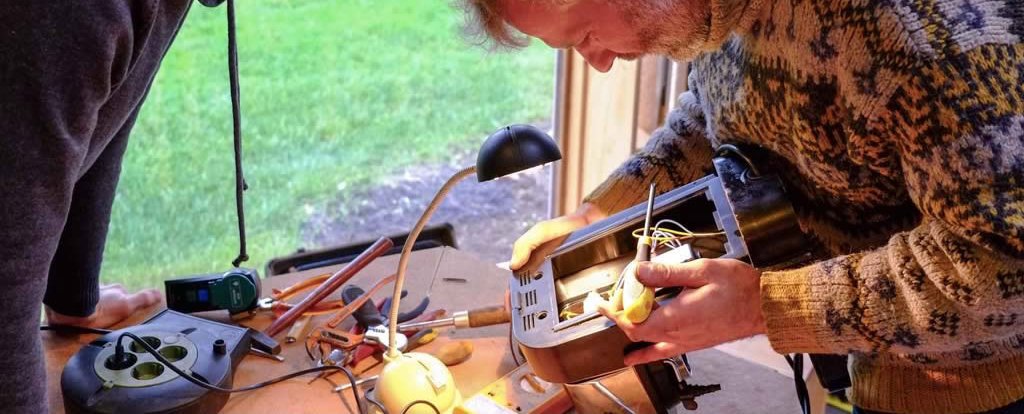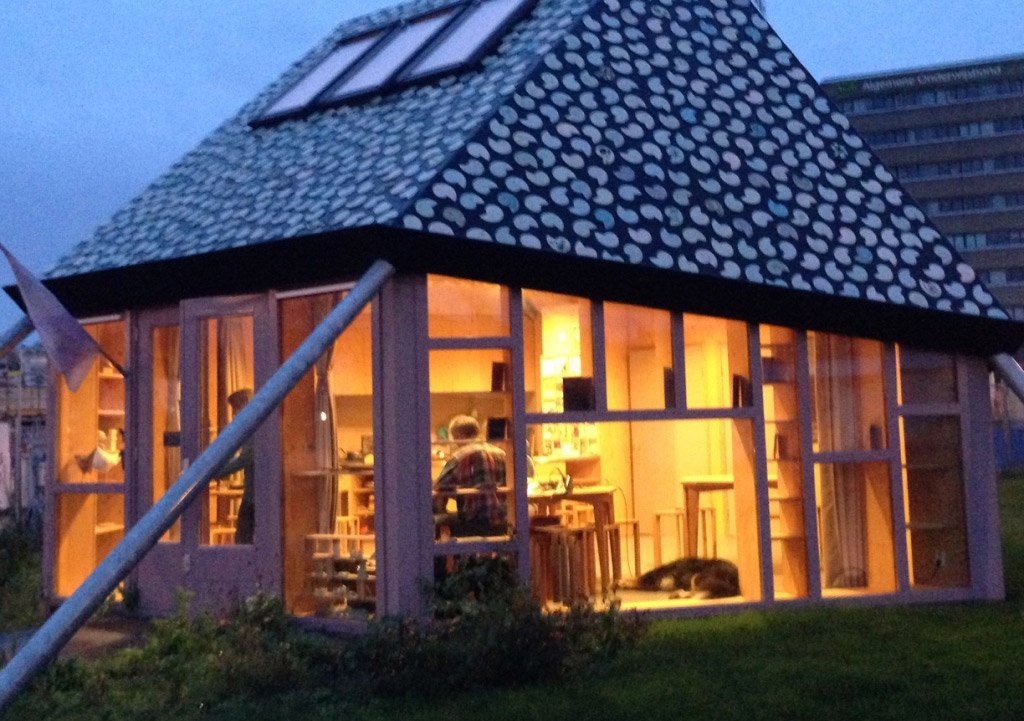
Repair Café Repair Café Utrecht At a Repair Café, handy volunteers will help you repair your things. Anything that can be transported fairly easily will be tackled: household appliances, electronics (such as CD and DVD players), lamps, tools (electrical and mechanical), toys, clothes and household textiles, small (garden) furniture and ... , a place where repair specialists fix broken things for free, is clear in concept, yet complex in practice. Perhaps we are too used to throwing things away and a second life sounds too good to be true? Whatever the hesitation to enter a Repair Café, it is alleviated after visitors set foot through the door.
- Man with broken chainsaw
- Woman with broken coffee bean grinder
- Woman with broken espresso machine
- Man with broken espresso machine
- Man with broken laptop
- Woman with broken espresso machine
“Welcome to the Repair Café! Can I get you something to drink? Coffee, tea...” welcomes Eva, all smiles, as I watch visitors trickle in on a rainy Saturday afternoon.
With broken objects in hand, visitors sit down by their respective Repair Specialist. After a brief exchange and a damage assessment, the repair session begins. What follows is a symphony of mechanical sounds: drilling, knocking, and clicking that ebb and flow across different repair stations. The buzz is only punctuated by silent pauses to reassess the operation of devices.
A successful repair is unmistakably marked by a burst of cheers when the object is revived. If the object is beyond repair, the visitor and the repairman share a mutual sense of regret and relief knowing that they have done their best.
Such is the standard workflow of a Repair Café, a concept originated by Martine Postma in 2009 in Amsterdam. Now a global phenomenon with 980 locations in 24 countries, Repair Café has 10 locations in Utrecht alone. I corresponded with Nina Blanken, the communications officer at the Repair Café Foundation (Stichting Repair Café), about the past and future of the growing initiative:
People who have repair skills to share, who might otherwise be sidelined, are getting involved again. Nina Blanken
CL: What is the origin of the Repair Café?
NB: People who have repair skills to share, who might otherwise be sidelined, are getting involved again. Valuable practical knowledge is getting passed on. Things are being used for longer and don’t have to be thrown away. This reduces the volume of raw materials and energy needed to make new products. It cuts CO² emissions, for example, because manufacturing new products and recycling old ones cause CO² to be released.
The Repair Café teaches people to see their possessions in a new light and, once again, to appreciate their value. The Repair Café helps change people’s mindset. This is essential to kindle people’s enthusiasm for a sustainable society.
But most of all, the Repair Café just wants to show how much fun repairing things can be, and how easy it often is.
CL: What is your long term vision for the Repair Café, for example, education, expansion, etc.?
NB: Martine Postma has a New Year’s dream: Repair Café lessons for all primary school students. In the coming year, Stichting Repair Café will work together with interested teachers to make a curriculum.
CL: During my visit, I noticed that visitors tend to be older. Why do you think that is and is there a plan to attract younger demographics?
NB: I have spoken with younger people about this and there are a few reasons. We don’t offer 24/7 service. They often don't know about it probably because publicity is not targeted at this younger audience. Also, we young people like to buy stuff... new or second hand.
However, we have a plan to reach more purposefully to younger people. If the repairers get better at repairing small consumer electronics like smartphones, tablets and laptops, the Repair Café will be more attractive to younger visitors. We are currently talking to partners who may train Repair Café volunteers in this area.
CL: Each Repair Café is independently operated. How do you oversee the operations? What are the biggest organizational and structural challenges facing the Repair Café?
NB: We have a starter kit that has some rules and guidelines. We can't oversee how each Repair Café is managed. Local Repair Cafés need to find and keep good, enthusiastic volunteers: people that can repair and communicate with visitors. They also need a location, tools and publicity.
CL: Why do you think people volunteer at the Repair Café?
NB: People like to be together, [to] share their knowledge, [to] repair things, and do something for the environment.
CL: Do you ever intend to repair non-material things?
NB: You mean a broken heart? No.
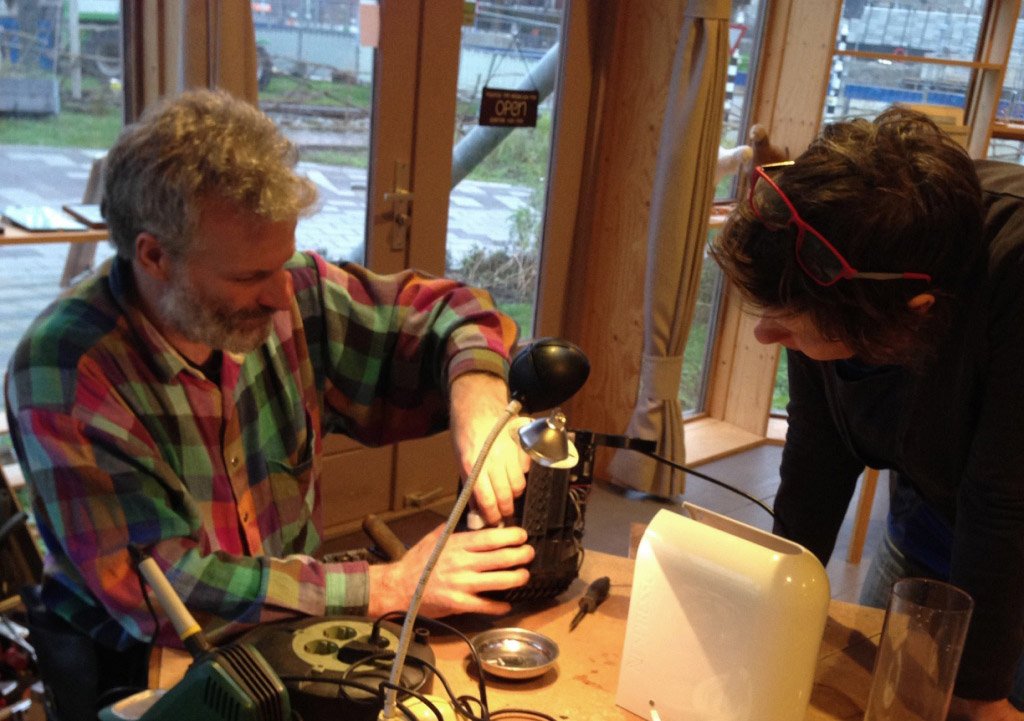
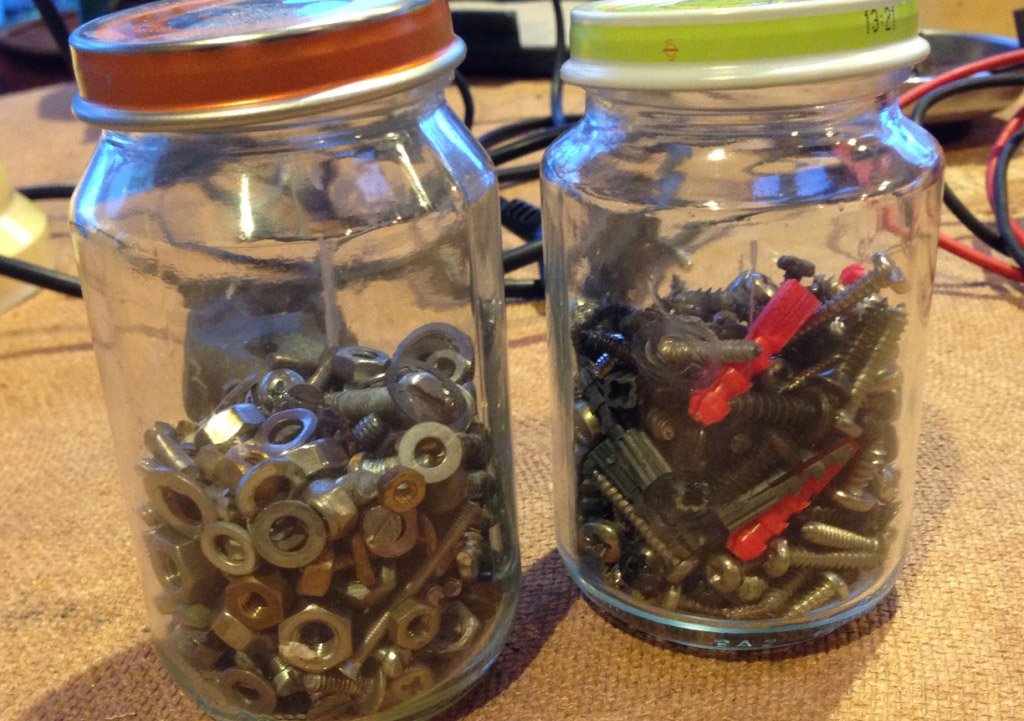
The biography of a thing: determining an object’s value
The woman with the coffee bean grinder sits down and waits for the next available repair specialist. It is hard to date her coffee bean grinder just from looking at the classic design.
“It is actually from my grandma, from the ‘50s,” the woman says. “After she passed away, I started using it again. It stopped working a while ago and I thought that I would bring it to the Repair Café and give it a go...”
For this woman, and many others that come to the Repair Café, their objects carry long and complex stories. Objects may not be able to speak, yet they define users as much as users define them.
Anthropologist Igor Kopytoff (1986) points out that there is a tendency towards “conceptually separating people from things, and of seeing people as the natural preserve for individuation...and things are the natural preserve for commoditization.”
Sociologist Bruno Latour argues against this object-human divide and writes that “our social relations will rarely consist of human-to-human connections...or of object-object connections, but will probably zigzag from one to the other.”
This is to say that objects, similar to humans, have social lives too. To better understand our material culture, we must also analyze the biography of the objects. Kopytoff invites us to ask the following questions:
Where does the thing come from and who made it? What are the recognized “ages” or periods in the thing’s “life,” and what are the cultural markers for them? How does the thing’s use change with its age, and what happens to it when it reaches the end of its usefulness?
I ask the volunteers if they are ever curious about where the broken objects come from.
“I once saw a vintage Dutch dollhouse that seemed to be the dollhouse owned by the visitor since he/she was a child. It could very well be an heirloom in the family,” remarks Eva.
Raymond, a Repair Specialist also recalls, “We typically don’t ask visitors the story behind their objects, but there is a lady that comes in regularly for small repair jobs. Sometimes she brings in items clearly beyond repair. Last week, she came by with broken Christmas lights that were not worth fixing in my opinion. Nevertheless, I tried to help. In the process, she revealed to me that she was autistic and these visits give her comfort and the needed human contact.”
It is a tall order to say that Repair Cafés can repair broken hearts. However, objects can sometimes mediate and restore social relationships. This is what elevates and endows objects with values that far exceed pure economic worth, unbeknownst to the very hands that bring these objects a second life at the Repair Café.
A gift that does nothing to enhance solidarity is a contradiction. Mary Douglas, The Gift
We have looked at the social and economic relationships between visitors and objects, but what about the volunteers? What is their place in this network of humans and objects?
The Repair Café operates in a space that is independent of market stipulation. From an economic point of view, volunteers participate in a gift economy where they devote their time and knowledge to an endeavor without explicit returns. While I do not doubt the intention and conviction of the volunteers, I feel the need to re-examine our understanding of the “free gift” - in this case, labor time and repair services free of charge.
In his book The Gift, sociologist Marcel Mauss points out that gifts circulate in a system of reciprocity instead of singularity. Anthropologist Mary Douglas further sheds light on Mauss’ text challenging the “free gift” misnomer:
(Un)usual Business note: We think reciprocity is crucial to build the solidarity that is needed in a society based on the commons. You have to be willing to help one another and trust others to be there for you when you need them, without expecting immediate return.
What is wrong with the so-called free gift is the donor’s intention to be exempt from return gifts coming from the recipient. Refusing requital puts the act of giving outside any mutual ties. Once given, the free gift entails no further claims from the recipient. The public is not deceived by free gift vouchers. For all the ongoing commitment the free gift gesture has created, it might just as well never have happened.
If Mauss is right, the volunteers are probably experiencing a kind of intangible reward. This is not surprising; most of us can relate to the joy of helping others. What is intriguing is the way Repair Specialists grapple to concretize the sense of fulfillment from volunteering.
One bike repair specialist thinks long and hard when I ask him about his motivations to volunteer. He eventually tells me a story to illustrate his point. He says that one day a handicapped man came in with his custom-made bike. The man complained of some nuisance from the bike. After a closer look at the bike, the Repair Specialist found the brake barely hanging on. Both men knew that it was a close call and that the owner had narrowly prevented a potentially life-threatening situation. In a very concrete way, this Repair Specialist found fulfillment in circumventing an accident.
Ruud, a Repair Specialist, puts it most succinctly when I ask him why he returns to the Repair Café time and time again. “I guess it’s gezellig (beloved Dutch word for a cozy and general convivial feeling)” he said.
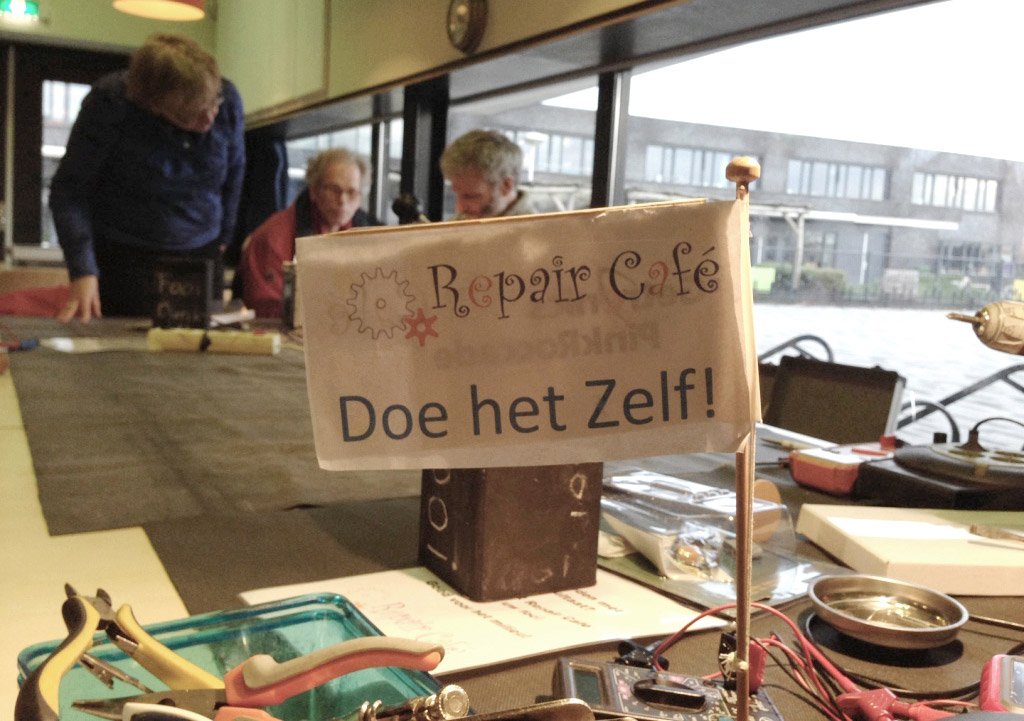
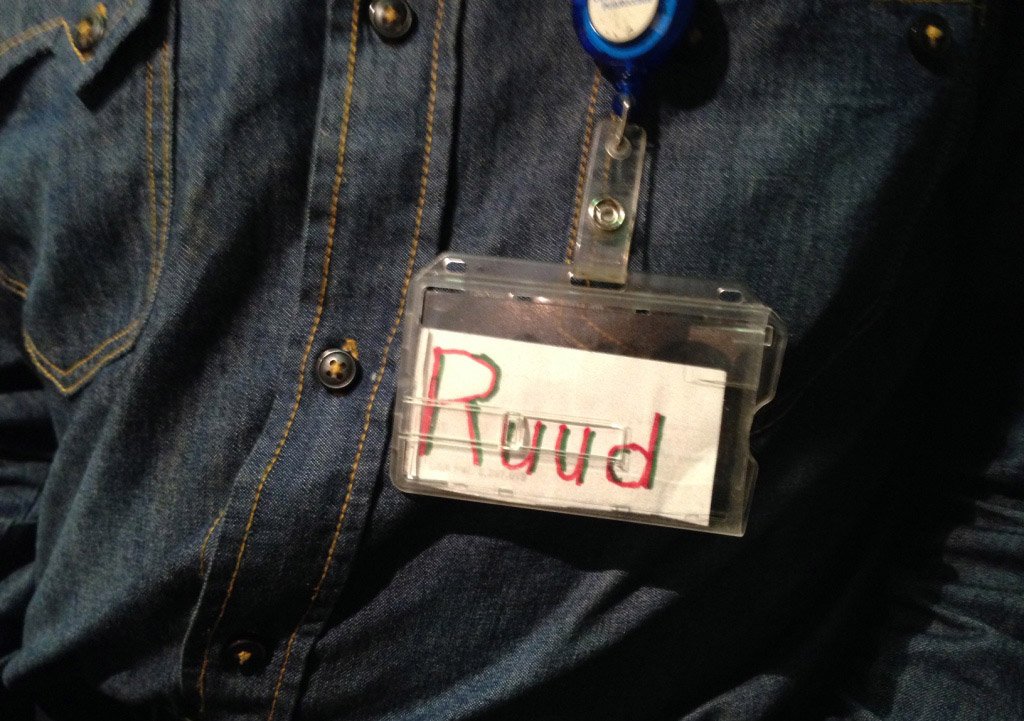
Circular economy: revelations from glitchy coffee makers
“What is the most popular item that you have had to repair?” I ask each Repair Specialist. Almost unanimously, the answer is “Philips Senseo Espresso Maker.”
It is so widely repaired that one of the volunteers has made a repair manual specifically for this product and shared the manual across all Repair Cafés in the Netherlands. A quick search on YouTube also returned hundreds of homemade tutorials for troubleshooting this product.
Taco, a veteran Repair Specialist, tells me that it is much easier to repair the coffee bean grinder from the 1950s than a similar piece of equipment manufactured today. In Taco’s words:
A few decades ago, consumer products were made so that you could disassemble them and replace broken parts when necessary. Now, products are made in one piece, making it very challenging and expensive to repair. Most people just end up throwing the whole thing away.
Taco’s comment about the life histories of these commodities shows that knowledge is fragmented between producers, distributors, and consumers as our capitalist society increasingly subdivides production into multiple specialized compartments in order to increase efficiency and save on cost. This knowledge gap inevitably creates growing consumer ignorance.
Objects that are increasingly manufactured with limited life span reflect “built-in obsolescence” - a business strategy to encourage consumers to buy a new model instead of trying to salvage the old one.
In the book Cradle to Cradle: Rethinking the Way We Make Things, authors Michael Braungart and William McDonough point out that objects with planned obsolescence are products of a “cradle to grave” manufacturing system. In the “cradle to grave” model, the product lifecycle is linear, going from consumer to a landfill or incinerator in a relatively short time.
This model produces tremendous waste. Products that could have been degraded and reused are simply sitting in the landfill. Braungart and McDonough reveal:
What most people see in their garbage cans is just the tip of a material iceberg; the product itself contains on average only 5 percent of the raw materials involved in the process of making and delivering it.
A study conducted by the United Nations Environmental Programme projected that by 2050 we will have doubled our consumption of minerals, fossil fuels, and biomass to 140 billion tons.
Conversely, a “cradle to cradle” model supports circular economies. By design, products in a circular economy minimize waste and pollution. At the end of its lifecycle, a product will break down into bio-nutrients that can safely enter the biosphere, or into industrial nutrients that can be reused for future industrial production.
The European Environmental Commission, in collaboration with a network of grassroots partners including the Repair Café, is currently drafting policies that support circular economies. In a joint mission statement published in 2015, the committee proposed plans that require manufacturers to produce repairable products with non-proprietary parts, as well as to communicate the expected product lifespan to consumers. Lastly, the mission statement calls for reducing the VAT on repair activities as an incentive.
(Un)usual Business note: What does this collaboration with EU institutions mean for the autonomy of Repair Café? What does it mean that the voluntary work and expertise of the repair specialists is used and deployed by an authority like the EU? Does Repair Café run the risk of having their good intentions co-opted and exploited?
Last Thoughts
As inspiring as it is to see Repair Cafés at the forefront of change, I realize the difficulty of assessing their effectiveness. It will be a long road to align policies, businesses, and consumers towards a circular economy. However, any large-scale change starts with a gradual and collective shift in the individual mindset.
The Repair Cafés have prompted me to rethink my relationship with the material world and to acknowledge that humans construct machines as much as machines construct our habits, behaviors, economies, and, ultimately, our histories.
Perhaps for some, visiting a Repair Café is not all about sustainability. It is simply about having coffee with others who come with broken espresso machines.
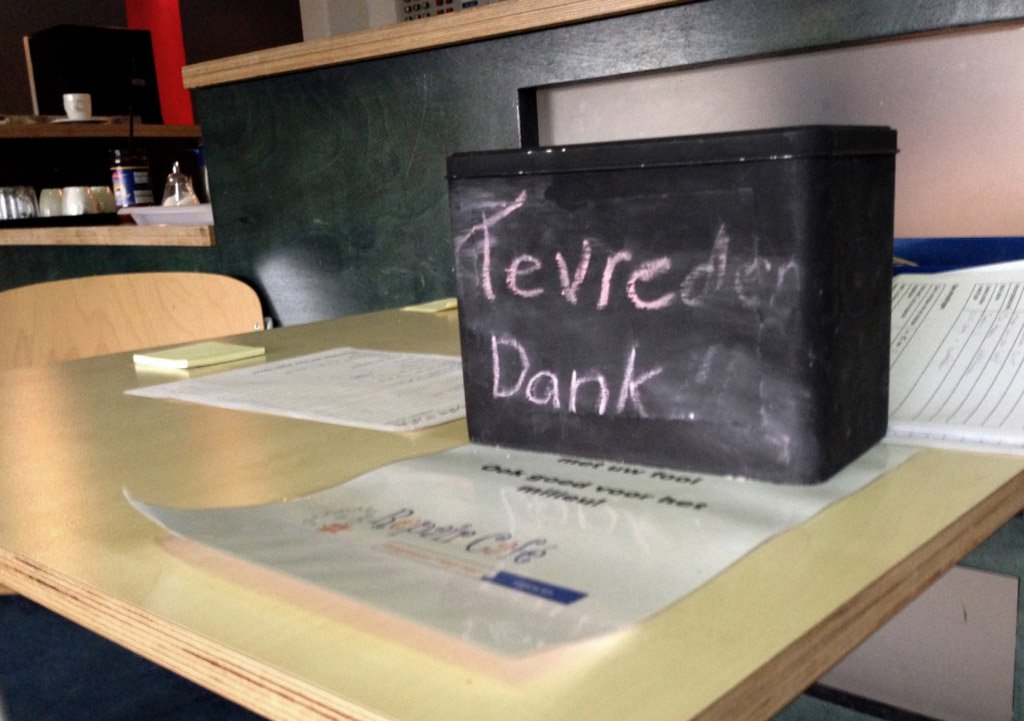
Top Repair Items
Espresso machines
Vacuum cleaners
Bikes
Printers
Microwave
Fax machines
Strangest Things to Repair
Vibrator (Rumours has it that it was repaired off-site for privacy)
References
Kopytoff, I. (1986). The cultural biography of things: commoditization as process. The social life of things: Commodities in cultural perspective, 68, 70-73.
Latour, B. (2005). Reassembling the Social-An Introduction to Actor-Network-Theory, by Bruno Latour. Oxford University Press.
Mauss, M. (1990 [1954]). The Gift: forms and functions of exchange in archaic societies. Routledge.
Douglas, Mary (1990). Foreword: No free gifts. The gift: form and functions for exchange in archaic societies, 7-18.
McDonough, W., & Braungart, M. (2010). Cradle to cradle: Remaking the way we make things. MacMillan.
Repair Café. Europe Ready for Circular Economy. 06 Oct. 2015. Retrieved on 1 March, 2016 from http://repaircafe.org/en/europe-ready-for-circular-economy/
This article was published in the (Un)usual Business journal Utrecht Meent Het #2 (September, 2016).

